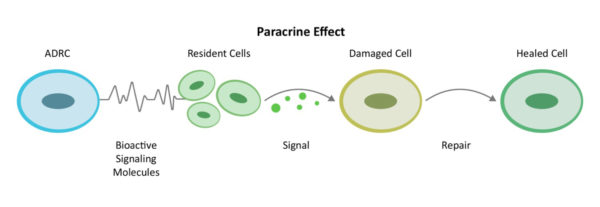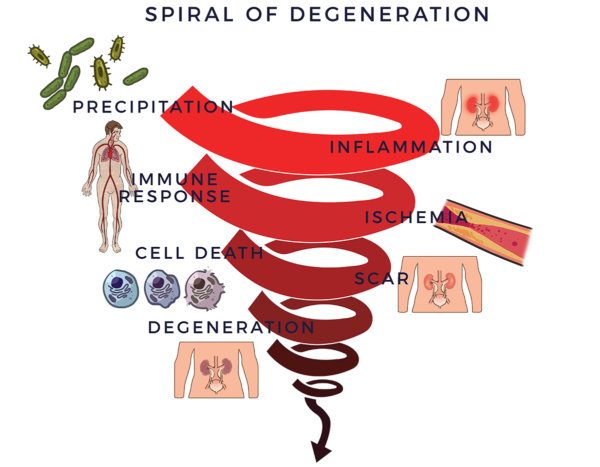Клеточная терапия AMBROSE при заболеваниях почек
В 2010 году, как это обычно бывает в новой области исследований, группа ученых провела исследование на животных, чтобы проверить потенциальную безопасность и эффективность стволовых и регенеративных клеток, полученных из жировой ткани (ADRCs), для лечения острого заболевания почек.
Результаты оказались неожиданно положительными: терапия ADRC резко снизила смертность: 100% мышей, прошедших лечение, выжили по сравнению с 57%, получавшими плацебо (контроль). Кроме того, у леченных мышей значительно снизился уровень креатинина в сыворотке крови по сравнению с контрольной группой.[1] После этого исследования ряд других исследований острых и хронических заболеваний почек у мелких и крупных животных, а также у людей показал, что взрослые стволовые клетки и другие регенеративные клетки из жировой ткани потенциально могут помочь предотвратить прогрессирование заболевания, снизить уровень креатинина в сыворотке крови, обратить вспять фиброзный рубец (фиброз) и улучшить кровоток.[2] [3] [4] Исследования на людях также показали улучшение функции почек после лечения стволовыми клетками.[5]
Стволовые и регенеративные клетки, полученные из жировой ткани (ADRCs)
Жировая ткань тела, известная в медицине как жировая ткань, является привлекательным источником стволовых и регенеративных клеток благодаря своей доступности, обилию и силе по сравнению с другими тканевыми источниками, такими как костный мозг, пуповина и плацента. ADRCs могут быть собраны, обработаны и повторно введены у постели больного в течение одного дня, и благодаря многочисленным биологическим действиям были использованы для улучшения симптомов, функций и качества жизни при широком спектре заболеваний, включая острые и хронические заболевания почек.[6] [7]
Спираль дегенерации
Хронические дегенеративные заболевания, в том числе почечная недостаточность, протекают по схожей схеме.
Травмы, инфекции, токсины из окружающей среды, нездоровый образ жизни (например, курение), наследственные факторы или сочетание этих негативных факторов могут вызвать воспалительную реакцию. Этот тип воспаления (острый) необходим для восстановления организма и обычно длится недолго, исчезая после завершения процесса заживления.
Существует и другой тип затяжной воспалительной реакции, которая становится хронической и затрагивает весь организм, приобретая системный характер.[8] Системное воспаление является общим фактором заболеваний старения - оно охватывает широкий спектр тяжелых, изнурительных, а иногда и опасных для жизни состояний, в том числе почечную недостаточность.[9] [10]
В случае дегенеративных заболеваний хроническое воспаление запускает порочный дегенеративный процесс. Он задействует иммунную систему, которая призвана бороться с инфекциями и другими болезнями, а также способствовать выздоровлению. Клетки иммунной системы (иммунные клетки) призваны охранять организм. Когда они чувствуют врага, они посылают войска провоспалительных молекул, называемых “цитокинами”, чтобы дать ему отпор. Когда этот процесс выходит из-под контроля, он называется воспалительно-иммунной реакцией. Такая реакция равносильна тому, как если бы у вас был водитель на заднем сиденье, который хронически неадекватно реагирует на ситуацию, “помогая” вам управлять автомобилем. Иммунный ответ приводит к снижению кровотока (ишемии). Без хорошего кровообращения клетки отмирают, образуются рубцы и фиброз, ткани и органы деградируют. Мы называем это спиралью дегенерации и используем ее в качестве основы для понимания некоторых ключевых факторов заболевания почек.
Потеря функции почек связана с воспалением, поражающим почечную (почечную) фильтрующую систему и их мелкие кровеносные сосуды. Хорошо известно, что хроническая болезнь почек связана с диабетом и неконтролируемым высоким кровяным давлением, постепенно ухудшающим функцию почек с течением времени. Ранние стадии обычно протекают без симптомов. Острые заболевания почек могут быть быстро спровоцированы недостаточным количеством жидкости в организме (при различных заболеваниях) и приемом некоторых лекарств.
Процесс ремонта
Благодаря механизму межклеточной коммуникации, известному как паракринный эффект, ADRC мобилизуют близлежащие клетки для более эффективной работы. Они привлекают к работе биологические пожарные, спасательные и ремонтные службы в месте расположения стволовых клеток-резидентов, чтобы те вернулись к работе и выполнили свою часть работы.

Привлекая дополнительных "ремонтников" (стволовые клетки-резиденты), чтобы они вернулись к работе и внесли свой вклад, ADRC собирают расширенную команду и сначала работают над уменьшением воспаления и гиперактивных иммунных реакций. После того как "заднее сиденье" уменьшится, они продолжают свою работу, усиливая кровообращение за счет роста новых кровеносных сосудов, предотвращая дальнейшую гибель клеток, устраняя рубцовую ткань и восстанавливая здоровые ткани и нервы. Так происходит естественное оздоровление организма, но если острое или хроническое заболевание наносит ему слишком сильный удар, ему необходима помощь.
Мы называем это процессом восстановления. Он включает в себя множество механизмов действия, необходимых для приведения системного воспаления и иммунного ответа в равновесие.
Клеточная терапия AMBROSE при заболеваниях почек
Поскольку основные факторы спирали, о которых говорилось выше, вовлечены в почечную недостаточность, а многочисленные механизмы восстановления ADRCs, как было показано, могут обратить вспять эти эффекты при этом состоянии, а также при ряде других серьезных заболеваний, пациенты с заболеваниями почек могут потенциально получить пользу от клеточной терапии AMBROSE.
Исследования на животных показали, что стволовые клетки уменьшают острое повреждение почек, активируя специализированные белые кровяные клетки, которые инициируют заживление и восстановление тканей почек, а также защищают от преждевременного старения клеток.[11] [12] [13]
Аналогичным образом было показано, что лечение стволовыми клетками хронических заболеваний почек у животных способствует восстановлению выработки энергии в почечных клетках.[14] [15], уменьшение рубцов[16], И уменьшает воспаление.[17]
Клеточная терапия AMBROSE представляет собой минимально инвазивный вариант лечения для пациентов с заболеваниями почек. Пожалуйста, свяжитесь с нами, чтобы получить дополнительную информацию о лечении, кандидатуре и о том, как стать пациентом.
[1] Z Feng et al Свежие и криоконсервированные, некультивированные стволовые и регенеративные клетки, полученные из жировой ткани, смягчают острое повреждение почек, вызванное ишемией-реперфузией, Нефрология Диализ ТрансплантацияТом 25, Выпуск 12, 1 декабря 2010 г., Стр. 3874-3884
[2] C Donizetti-Oliveira Лечение стволовыми клетками, полученными из жировой ткани, предотвращает прогрессирование почечной болезни Трансплантация клеток, том 21, стр. 1727-1741, 2012
[3] A Eirin et al Мезенхимальные стволовые клетки, полученные из жировой ткани, улучшают результаты реваскуляризации для восстановления функции почек при атеросклеротическом стенозе почечной артерии у свиней Стволовые клетки. 2012 May; 30(5): 1030-1041
[4] JJ Rivera-Valdés et al. (2017) Стволовые клетки, полученные из жировой ткани человека, регрессируют фиброз в модели хронического почечного фиброза, индуцированного аденином. PLoS ONE 12(12)
[5] Эль-Ансари М, Саади Г, Абд Эль-Хамид СМ. Мезенхимальные стволовые клетки - спасительный подход для восстановления ухудшающейся функции почек. Нефрология 2012;17:650-657.
[6] Guo et al Стромальные сосудистые фракции: Регенеративная реальность? Часть 2: современные концепции и обзор литературы Journal of Plastic, Reconstructive & Aesthetic Surgery (2016) 69, 180e188
[7] JK Fraser PhD и S Kesten MD Аутологичные регенеративные клетки, полученные из жировой ткани: Платформа для терапевтического применения Advanced Wound Healing Surgical Technology International XXIX
[8] S. Амор Воспаление при нейродегенеративных заболеваниях Иммунология, 129, 154-169
[9] C. Franceschi and J. Campisi Chronic Inflammation (Inflammaging) and Its Potential Contribution to Age-Associated Diseases J Gerontol A Biol Sci Med Sci 2014 June;69(S1): S4-S9
[10] Suliman ME, Stenvinkel P. Вклад воспаления в развитие сосудистых заболеваний у пациентов с хронической болезнью почек. Saudi J Kidney Dis Transpl 2008;19:329-45
[11] Geng, Y.; Zhang, L.; Fu, B.; Zhang, J.; Hong, Q.; Hu, J.; Li, D.; Luo, C.; Cui, S.; Zhu, F.; et al. Мезенхимальные стволовые клетки смягчают вызванное рабдомиолизом острое повреждение почек через активацию макрофагов m2. Stem Cell Res. Ther. 2014, 5, 80
[12] Lee, S.J.; Ryu, M.O.; Seo, M.S.; Park, S.B.; Ahn, J.O.; Han, S.M.; Kang, K.S.; Bhang, D.H.; Youn, H.Y. Мезенхимальные стволовые клетки способствуют улучшению функции почек в модели повреждения почек у собак. In Vivo 2017, 31, 1115-1124
[13] Родригес К.Э., Капча Ж.М., де Браганка А.К., Санчес Т.Р., Гувейя П.К., де Оливейра П.А., Малхейрос Д.М., Вольпини Р.А., Сантиньо М.А., Сантана Б.А. и др. Мезенхимальные стромальные клетки пуповины человека защищают от преждевременного почечного старения, вызванного окислительным стрессом, у крыс с острым повреждением почек. Stem Cell Res. Ther. 2017, 8, 19
[14] Yoon, Y.M.; Han, Y.S.; Yun, C.W.; Lee, J.H.; Kim, R.; Lee, S.H. Pioglitazone protects mesenchymal stem cells against p-cresol-induced mitochondrial dysfunction through up-regulation of pink-1. Int. J. Mol. Sci. 2018, 19, 2898
[15] Lira, R.; Oliveira, M.; Martins, M.; Silva, C.; Carvalho, S.; Stumbo, A.C.; Cortez, E.; Verdoorn, K.; Einicker-Lamas, M.; Thole, A.; et al. Трансплантация мСК, полученных из костного мозга, улучшает функцию почек и активность na(+)+k(+)-атпазы у крыс с реноваскулярной гипертензией. Cell Tissue Res. 2017, 369, 287-301
[16] Wu, H.J.; Yiu, W.H.; Li, R.X.; Wong, D.W.; Leung, J.C.; Chan, L.Y.; Zhang, Y.; Lian, Q.; Lin, M.; Tse, H.F.; et al. Mesenchymal stem cells modulate albumin-induced renal tubular inflammation and fibrosis. PLoS ONE 2014, 9, e90883
[17] Абдель Азиз М.Т., Вассеф М.А., Ахмед Х.Х., Рашед Л., Махфуз С., Али М.И., Хуссейн Р.Э., Абдель Азиз М. Роль стволовых клеток, полученных из костного мозга, в ослаблении функции почек у крыс с диабетической нефропатией. Диабетол. Metab. Syndr. 2014, 6, 34



